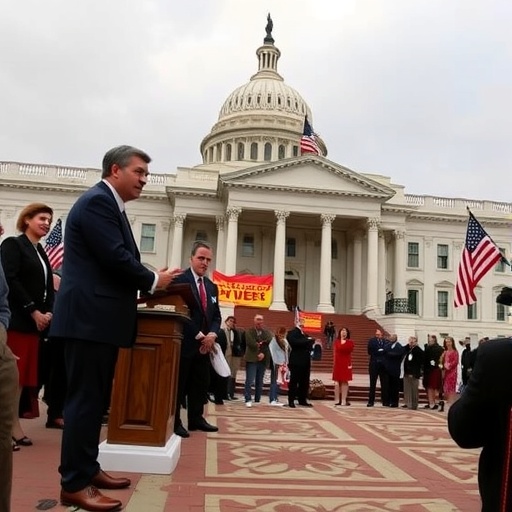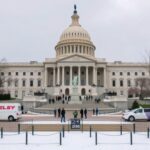US Senate Adjourns in Disarray: Government Shutdown Stalemate Persists After Seventh Failed Funding Bill Vote
In a dramatic escalation of the ongoing political crisis, the US Senate adjourned for the weekend on Friday evening, leaving the federal government on the brink of an extended shutdown after a seventh consecutive failed vote on a short-term funding bill. With lawmakers packing their bags and heading home without a resolution in sight, the stalemate in Congress ensures that the partial government shutdown will drag on for at least two more weeks, affecting millions of Americans and stalling critical national operations.
The vote, which took place late Thursday night, saw the funding bill—a stopgap measure designed to keep federal agencies running through mid-December—fall short by a margin of 48-52. This marked the latest chapter in a protracted battle over spending priorities, where Democrats and Republicans remain deadlocked on issues ranging from border security funding to disaster relief allocations. As the Senate leaves town, the weight of this impasse falls squarely on federal workers, small businesses, and everyday citizens who rely on uninterrupted government services.
Seventh Vote Crumbles Under Partisan Pressure
The Senate’s seventh attempt to pass the funding bill unfolded amid heightened tensions on Capitol Hill, where procedural hurdles and ideological clashes derailed what many hoped would be a straightforward bipartisan compromise. Senate Majority Leader Chuck Schumer (D-NY) had pushed for a clean continuing resolution (CR), a temporary funding extension that would avert the shutdown without delving into contentious policy riders. However, Republicans, led by Minority Leader Mitch McConnell (R-KY), insisted on amendments tying funding to stricter immigration controls and cuts to certain social programs, leading to the bill’s defeat.
According to Senate records, the vote breakdown highlighted the deep partisan divide: all 48 Democrats present voted in favor, while only four Republicans crossed the aisle to support the measure. This failure comes on the heels of six prior unsuccessful attempts since the fiscal year began on October 1, each one more acrimonious than the last. “We’ve reached a point where compromise feels like a relic of the past,” Schumer said in a floor speech before the vote, his voice echoing through the nearly empty chamber. The adjournment announcement followed swiftly, with no sessions scheduled until at least November 13, effectively punting the crisis into the post-election period.
Behind the scenes, negotiations had been ongoing for weeks, involving marathon sessions in the Senate Appropriations Committee. Yet, as one anonymous Senate aide revealed to reporters, “The funding bill became a proxy war for larger battles—immigration, defense spending, and even election-year posturing. No one wants to be the first to blink.” This stalemate isn’t isolated; it echoes the 2018-2019 shutdown, the longest in US history at 35 days, which cost the economy an estimated $11 billion according to the Congressional Budget Office (CBO).
Federal Agencies Reel from Prolonged Shutdown Uncertainty
As the Senate shutdown saga continues, federal agencies are bracing for the worst, with non-essential operations already scaled back and essential services operating on fumes. The Department of Defense, while partially funded through September, faces renewed threats to training exercises and maintenance contracts if the impasse persists. Meanwhile, the National Parks Service has shuttered sites like Yosemite and the Grand Canyon to visitors, a move that could result in $70 million in lost revenue per week, per estimates from the National Park Conservation Association.
Federal workers—over 800,000 of whom were furloughed or working without pay during the last major shutdown—are once again in limbo. The Office of Personnel Management reports that approximately 2.1 million civilian employees could be affected if the shutdown extends beyond the weekend. “It’s heartbreaking to see families planning around paychecks that might not come,” said Patricia, a Smithsonian Institution curator furloughed since the initial funding lapse. Her story, shared via a viral social media post, has garnered thousands of shares, underscoring the human cost of the congressional stalemate.
Economically, the ripple effects are profound. A recent Moody’s Analytics report projects that a two-week extension of the shutdown could shave 0.2% off US GDP growth in the fourth quarter, with small businesses near federal installations hit hardest. For instance, restaurants and hotels in Washington, D.C., which depend on congressional tourism, have seen bookings drop by 30% this week alone. The Small Business Administration (SBA), itself partially shuttered, warns that loan processing delays could exacerbate cash flow issues for entrepreneurs nationwide.
- Key Affected Areas: National parks closed to public access; IRS tax refund processing delayed; Head Start programs for low-income children at risk.
- Financial Toll: Up to $1.5 billion in weekly economic losses, per CBO projections.
- Worker Support: Emergency loans available through some credit unions, but many families turn to food banks amid uncertainty.
This isn’t just about bureaucracy; it’s about real lives upended. Veterans waiting for benefits through the Department of Veterans Affairs (VA) face appointment backlogs, while environmental monitoring by the Environmental Protection Agency (EPA) grinds to a halt, potentially missing critical data on climate impacts.
Key Lawmakers Trade Blame in Fiery Post-Vote Exchanges
The adjournment was preceded by a flurry of pointed rhetoric, as Senate leaders from both sides of the aisle pointed fingers amid the funding bill’s collapse. President Joe Biden, addressing the nation from the White House Rose Garden on Friday, urged Congress to “put politics aside and pass the funding bill without delay.” He emphasized the bipartisan nature of previous CRs, noting that similar measures passed with near-unanimous support in 2023.
Republican hardliners, however, doubled down on their stance. Senator Ted Cruz (R-TX), a vocal critic of the Democratic approach, tweeted post-vote: “Democrats refuse to secure the border—now the American people pay the price with this shutdown stalemate. Time for real leadership in the Senate.” Cruz’s comments drew sharp rebukes from Senate Minority Whip Dick Durbin (D-IL), who countered during a press briefing: “This isn’t about security; it’s about scoring points. The funding bill is essential, and we’re willing to negotiate, but not at the expense of basic governance.”
House Speaker Mike Johnson (R-LA), whose chamber passed a version of the bill earlier in the week, expressed frustration with the Senate’s inaction. In a statement to Fox News, Johnson said, “The House has done its part. The stalemate in the Senate is unacceptable and must end before it inflicts more damage on our economy.” Bipartisan voices, like that of Senator Susan Collins (R-ME), called for a return to the negotiating table, warning that the shutdown could erode public trust in Congress further, with approval ratings already hovering at historic lows of 18% according to a Gallup poll released this week.
These exchanges highlight the broader political calculus at play. With midterm elections looming, both parties are wary of appearing weak, yet the prolonged shutdown risks alienating voters. Political analyst Norman Ornstein of the American Enterprise Institute observed in an op-ed for The Washington Post: “This Senate stalemate is a self-inflicted wound. History shows shutdowns hurt the party in power, but in a divided Congress, everyone loses.”
Historical Echoes: Lessons from Past Shutdown Battles
The current Senate shutdown impasse isn’t without precedent; Congress has flirted with fiscal cliffs 21 times since 1976, resulting in 14 partial shutdowns. The most infamous was the 1995-1996 episode under President Bill Clinton, which lasted 21 days and stemmed from disputes over Medicare and welfare reform. That event led to a 2% drop in consumer confidence and cost taxpayers $1.4 billion, adjusted for inflation.
Fast-forward to 2013, when a 16-day shutdown over the Affordable Care Act rollout paralyzed government functions and delayed economic data releases, contributing to a 0.3% GDP contraction in the fourth quarter. The 2018-2019 shutdown, triggered by wall funding demands from then-President Donald Trump, affected 800,000 workers and led to a $3 billion hit to the Commerce Department alone. These historical shutdowns provide a stark backdrop to today’s stalemate, where the funding bill’s failure underscores recurring themes of polarization.
Experts at the Bipartisan Policy Center note that while short-term CRs have become routine—over 40 since 2010—the addition of poison-pill amendments has made passage increasingly difficult. In this cycle, the funding bill debate has intertwined with hot-button issues like Ukraine aid and green energy subsidies, complicating bipartisan efforts. A study by the Pew Research Center reveals that 72% of Americans now view government shutdowns as harmful to the economy, up from 58% in 2013, signaling growing public fatigue with congressional gridlock.
Looking at procedural angles, the Senate’s 60-vote filibuster threshold has been a persistent obstacle. Efforts to reform it, such as the “nuclear option” invoked for judicial nominations, haven’t extended to budget matters, leaving the chamber vulnerable to minority holds. As one veteran Senate staffer put it in an interview with Politico: “The funding bill was DOA because of the filibuster. Without changes, these shutdowns will keep happening.”
Outlook Hinges on Post-Adjournment Negotiations and Election Dynamics
With the Senate adjourned and the shutdown set to persist, the path forward remains murky, but several factors could influence the next moves in Congress. Informal talks between Schumer and McConnell are expected to resume via phone over the weekend, potentially yielding a revised funding bill stripped of divisive elements. However, sources close to the negotiations suggest that any deal would need House approval, where conservative Republicans hold sway and demand concessions on spending cuts.
The impending midterm elections add another layer of urgency. Polling from Quinnipiac shows that 65% of voters blame Congress equally for fiscal impasses, but incumbents in swing districts could face backlash if the shutdown drags into November. Advocacy groups like the US Chamber of Commerce have ramped up pressure, with CEO Suzanne Clark issuing a statement: “This stalemate threatens jobs and growth. Congress must act now to pass the funding bill and stabilize the economy.”
Looking ahead, if no resolution emerges by November 13, the shutdown could extend into the holiday season, amplifying disruptions to services like passport processing and FDA inspections. Optimists point to historical precedents where crises forced breakthroughs—such as the 1996 shutdown ending with a balanced budget agreement. Pessimists, however, warn of a “do-nothing Congress” legacy, with the CBO forecasting up to $18 billion in total costs if the impasse lasts a month.
Ultimately, breaking the Senate stalemate will require leadership willing to prioritize governance over grandstanding. As federal workers mark another uncertain payday and agencies scramble to maintain essentials, the eyes of the nation turn to Capitol Hill, awaiting signs that Congress can reclaim its role as the engine of American democracy.









